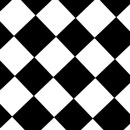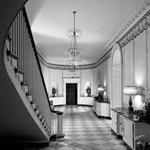
Harlequin
Harlequin refers to a checkered pattern (alternating colored squares) oriented in a 90° or a 45° angle typically made of marble, wood, or clay tiles. more
Harlequin | House
application
Harlequin as a black and white floor pattern is one of the oldest archetypical practices in house design, accommodating several styles and aesthetics.
research
Harlequin was already used in the early Renaissance. In Italy, for instance, decorated floors were common due to the availability of a wide variety of marble colors and types. Initially these floors were made up of small marble square sections which by the late 15th and 16th century gradually increased.1 The Roman tradition of floor decoration rapidly extended all through out Europe. Taking from the Romans, Robert Adam made of floor decoration an essential aesthetic component of his designs using them to unite the overall composition.2 For example, in 1761 for the remodelation of the Great Hall in the Syon House in London, Adam designed a black and white Harlequin marble floor with incorporated bands corresponding with the ceiling panels.3
Harlequin floors were also used in Germany during the Baroque and Rococo. In the Rococo, Harlequin was commonly found composed of a variety of pastel colors as well as with natural motifs inserted in the middle of the design. In the Kaisersaal residence, built in 1744 in Germany, Balthasar Neumann employed a pink and cream Harlequin floor to which he inserted several star motifs circumscribed within circles. In Holland, although marble floors were usual in the main ground floor halls, in upper rooms parquet was often the norm. Sometimes, the house of the wealthy was an exception of this norm. In the Authentic Decor: The Domestic Interior, 1620-1920, Peter Thornton depicts a bedchamber in a rich burgher’s house in 1630, Holland using Harlequin displayed in a 45° angle. During the Great Century, understood as the 17th century in Holland, rich burghers built brick houses, as the Mauritshuis in The Hague of 1633, with plain interiors –beamed ceilings, lattice windows, tables covered with rugs- and invariably Harlequin floors in contrasted colors of red or black and white.4
By the 1920s, Art Deco had influenced design becoming Harlequin a true representation of cubism and the clean straight lines in trend. Authentic Art Deco Interiors and Furniture in Full Color depicts the use of Harlequin in a variety of vibrant colors, mostly ceramic tiles, in settings as kitchens, bathrooms, and children’s rooms. All the settings show that the preference of the time was to install Harlequin in a right angle. This grid pattern was heavily influenced by the Wiener Werkstätte Stil which “stripped [pattern] . . . to its barest essentials: the pure geometry of checkerboards”.5 The Werkstätte designers applied black and white Harlequin to almost every decorative element including textiles and objects.
The black and white Harlequin was one of the “hallmarks” of Dorothy Draper, “America’s most fabulous decorator.”6 With it, she dazzled perspective producing it in an enormous scale -larger than the Romans did- to make furniture look like checker pieces and consequently achieve an over the top aesthetic. Also as a country Harlequin version, Draper employed bleached and hand-stenciled wood as shown in the entry way of the 1980s Hawley Cottage at Greenbrier.7
Contemporarily, Harlequin is not relegated just to floors but it is often used as a wall design. In spite of its previous presence in the form of small glazed tiles in the walls of kitchens and bathrooms for easy cleaning, today it acquires the form of painted murals comprising entire walls or even metal meshes dividing spaces. In a 1997 Chicago residence, interior designer Olafsen-Scheiber painted a black and white Harlequin pattern over a living room wall, while in the Lotus House in Japan, Kengo and Kuma Associates wrapped an entire house in a metal Harlequin lattice making the void parts read as black and the solid ones as white.
end notes
- 1) Jane Fawcett, Historic Floors: Their History and Conservation (Boston: Butterworth-Heinemann, 1998),148.
- 2) Fawcett, Historic Floors, 146.
- 3) Fawcett, Historic Floors, 146.
- 4) Fawcett, Historic Floors, 149-50.
- 5) Judith Gura, The Abrams Guide to Period Styles for Interiors (New York: Harry N. Abrams Inc., 2005), 276.
- 6) Carleton Valley, In the Pink: Dorothy Draper, America’s Most Fabolous Decorator (New York: Pointed Leaf Press, 2006), 46.
- 7) Valley, In the Pink, 207.
- 8) Evidence for the use and the chronological sequence of Harlequin as a house archetype was developed from the following sources: 1950 Walter Prokosh House [1951] Walter Prokosch Architect; Old Greenwich, CT; in John Hancock Callender, "Six East and West Coast Houses," Architectural Record 110, no. 5 (Nov. 1951): 130; PhotoCrd: Joseph Molitor; Vladimir Ossimpoff House [1955] Vladimir Ossipoff, Architect; Honolulu, Hawaii; in "Residence on a Windy Hilltop in Hawaii," Architectural Record 118, no. 3 (Sep. 1955): 199; PhotoCrd: R. Wenkam; Rendering [1956] Earl Perreault, Illinois Chapter AID in Anonymous, "AID-Decorator's Big Show," Interior Design 27, no. 3 (Mar. 1956): 112; PhotoCrd: Anonymous; Gourmet Kitchen, Private House [1956] Mrs. Willie May Baird, Interior Design, AID of The Strassel Co., Louisville and General Electric in Anonymous, "Contemporary Kitchens," Interior Design 27, no. 2 (Feb. 1956): 96; PhotoCrd: Anonymous; Dining Area, Edgar B. Lau House [1956] Pancoast, Fernendino, Skeels and Burnham, Architect; James Merrick Smith Associates, Interior Design, AID; FL in Anonymous, "Triumvirate of Tastes," Interior Design 27, no. 11 (Nov. 1956): 78; PhotoCrd: Anonymous / 1970 Study, Peter and Adela Holzer Townhouse [1977] Ruben de Saavedra; Manhattan, NYC in Anonymous, "Spanish Flair," Interior Design 48, no. 5 (May 1977): 166; PhotoCrd: Daniel Eifert / 1990 Frank McGuire and Deborah Hanley Vacation House [1991] Perry Dean Rogers and Partners; MA in M. Gaskie, "Little House in a Meadow," Architectural Record, Record Houses 1991 (Apr. 1991): 114; PhotoCrd: Steve Rosenthal; Vacation House [1997] Donato Savoie and Antonio Morello, Studio Morsa; Nevis Island, West Indies in Edie Cohen, "Paradise Found," Interior Design 68, no. 5 (Apr. 1997): 174; Photo.Crd: Antone Bootz / 2000 Lotus House [2006] Kengo Kuma and Associates; Eastern Japan in Naomi Pollack, "Lotus House," Architectural Record 77, no. 4, Record Houses 2006 (Apr. 2006): 102; PhotoCrd: Edmund Sumner.
bibliographic citations
1) The Interior Archetypes Research and Teaching Project, Cornell University, www.intypes.cornell.edu (accessed month & date, year).
2) Mendez, Marta. “Theory Studies: Archetypical Practices of Contemporary House Design.” M.A. Thesis, Cornell University, 2008, 76-87.


